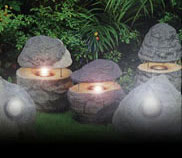|
|
What to Consider When Planning Low Voltage LightingWhen creating a low voltage lighting design for your property, you should consider the following important steps. First select the appropriate light fixtures. Each type of lighting is best suited to a specific purpose. Next make sure you have an adequate power supply. Be prepared to install additional power outlets if necessary. Next, when you create your lighting layout, pay attention to how each light will connect back to the power supply. Finally calculate how much cable you'll need and the size of the transformer. Piece of cake! Select the Light Fixture that Best Suits the Application
Locate or Install 110/120 Volt Power OutletThe location of the power outlet has an impact on the layout of your lights and cable runs. A transformer plugs into a standard AC outlet and it reduces the line voltage from from 110/120 volts to 12 volts. If you don't have power outlet outside where you want, get a certified electrician to install one for you. You can use a power outlet located indoors, but make sure the transformer is rated for indoor use as well as outdoor. Also make sure there is at least three inches of space around the transformer to allow heat to adequately dissipate. Create a Lighting LayoutUse graph paper to draw your area to scale and then plan your outdoor lighting layout. Experts like Residential Landscape Lighting and Design suggest grouping your lights in clusters of 3 to 6. Cabling connects each light in a cluster and a T-connector allows a single cable run back to the transformer. You can also connect light clusters using a continuous loop from the transformer. Plan multiple clusters of lights with cable runs back to the transformer instead of one cable run that has all the lights connected to it. Make sure the total wattage of the lights in each cluster does not exceed 240 watts. Determine the Voltage Delivered to Each FixtureOnce your lighting clusters are arranged, you have to calculate the voltage that will be delivered to each fixture. Even though low voltage lighting runs on 12 volts, each light fixture does not receive that voltage because of the distance of the fixture from the power source (cable length to the transformer), the number of fixtures sharing that cable run (total wattage), and the size of wire being used. To calculate voltage dropMultiply the distance from the transformer to the fixture by the total wattage of all the fixtures on the cable run and then divide by the cable constant for the gauge of wire you are using. For 12 gauge wire, the cable constant is 7500. cable length x total Watts The voltage delivered to the light fixture is actually 12 volts minus the voltage drop. You need to know the voltage drop in your design because if affects how the light fixture performs. If there is too much voltage drop, the light burns much dimmer. If there is not enough voltage drop, the light can burn out too quickly. To manage voltage drop, aim for no more than 100 Watts on 100 feet of cable. In other words, for each cable run of 100 feet, plan for light fixtures totaling no more than 100 Watts (for example, 3 x 30 Watts). Determine the Length of Cable12 gauge 2 connector wire, also called 12/2 direct burial wire is ideal for low voltage landscape lighting. It is designed to withstand years of above or below ground exposure. Once you know where the transformer is located and have designed the cabling runs, you can calculate how much low voltage wire you need. You can also use a rope or garden hose to visualize the wire layout and then measure the length of the rope or garden hose. Add an extra 10% just in case. Determine the Size of TransformerThe size of transformer you need depends on the number of light fixtures. First determine the total wattage in your design by adding up the watts of each light fixture. Then select a transformer that has a higher wattage capacity than the total wattage so that you can change or expand your lighting design in the future if necessary. If you have a large design with many lights, you may require multiple transformers. |
|
|||||||||||||||
|
|||||||||||||||||
|
|
|||||||||||||||||


 First
decide what you want to illuminate and then look at the fixtures that suit that
purpose. For stairs and steps, choose recessed brick lights or post mounted step
lights. For pathways, choose area lights, path or stake lights. For
First
decide what you want to illuminate and then look at the fixtures that suit that
purpose. For stairs and steps, choose recessed brick lights or post mounted step
lights. For pathways, choose area lights, path or stake lights. For
